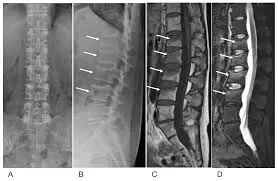Estimated incidence of pregnancy and lactation-associated premenopausal osteoporosis higher with risk of Vertebral fracture: Study

The estimated incidence of pregnancy and lactation-associated premenopausal osteoporosis is higher with the risk of Vertebral fracture suggests a study published in the BMC Pregnancy and Childbirth.
Pregnancy and lactation-associated osteoporosis (PLO), as well as premenopausal osteoporosis, might be a predictor of future fracture. This study aimed to describe the clinical features of PLO as a subtype of premenopausal osteoporosis and to evaluate medical interventions for it. From an administrative claims database including 4,224,246 people in Japan, we classified women for whom the date of childbirth had been defined and who had suffered low-trauma fracture between the ages of 18–47 years as the premenopausal osteoporosis group. A fracture site for which the odds ratio for fractures occurring between 5 months before and 12 months after childbirth (around childbirth) was greater than 1 was considered the PLO site. We classified patients with a fracture at the PLO site around childbirth as the PLO group. The control group consisted of 500 women without fragility fractures. We investigated some drugs and diseases to explore fracture-causing factors, as well as medical interventions such as osteoporosis diagnosis, bone densitometry, anti-osteoporosis pharmacotherapy, and lactation inhibitors. Results: In total, 231 parous women were classified into the premenopausal osteoporosis group. The most common fracture was vertebral fracture and was likely to occur around childbirth, followed by distal radius and sacral fractures, which were rare around childbirth. Considering vertebral, pelvic, and proximal femoral fractures as PLO sites, 56 women with 57 PLO fractures were classified into the PLO group. The incidence of PLO was estimated at 460 per million deliveries. Ovulation disorder and high maternal age were associated with the development of PLO. Vertebral fracture was the most common PLO fracture. It was mainly diagnosed a few months, and possibly up to 1 year, postpartum. PLO patients with vertebral fractures underwent more medical interventions than did those with other fractures, but they were still inadequate. PLO with vertebral fracture was one of the major types of premenopausal osteoporosis. The prevalence of PLO is considered to be higher than previously thought, indicating the presence of potentially overlooked patients. More timely interventions for PLO might lead to the improved management of latent patients with premenopausal osteoporosis and reduce future fracture risk.
Reference:
Kasahara, K., Tanaka-Mizuno, S., Tsuji, S. et al. Pregnancy and lactation-associated osteoporosis as a major type of premenopausal osteoporosis: a retrospective cohort study based on real-world data. BMC Pregnancy Childbirth 24, 301 (2024). https://doi.org/10.1186/s12884-024-06520-0
Keywords:
BMC Pregnancy and Childbirth, Kasahara, K., Tanaka-Mizuno, S., Tsuji, S, Fracture, Lactation, Osteoporosis, Pregnancy, Premenopausal



